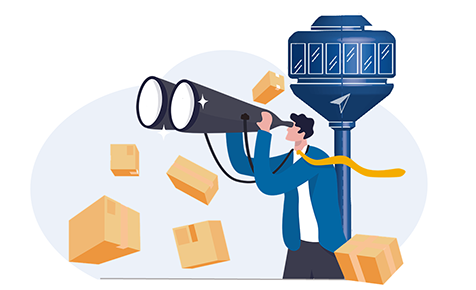
Distributed fulfillment is transforming how ecommerce brands manage logistics, reduce shipping costs, and meet customer delivery expectations.
Distributed fulfillment is a logistics strategy where ecommerce orders are shipped from multiple locations – such as warehouses, stores, or third-party partners – rather than from a single centralized facility. As ecommerce scales and customer expectations rise, distributed fulfillment is helping brands deliver faster, reduce shipping costs, and operate more efficiently across regions.
Here’s how distributed fulfillment works, why it’s gaining momentum, and what operations leaders need to make it succeed.
What Is Distributed Fulfillment?
Distributed fulfillment is the process of storing and shipping products from multiple locations – such as regional warehouses, retail stores, third-party logistics (3PL) providers, micro-fulfillment centers, or regional wholesale distributors – rather than from a single, centralized distribution center.
Distributed fulfillment is helping brands deliver faster, reduce shipping costs, and operate more efficiently across regions.
Orders are routed to the fulfillment location best positioned to meet the customer’s delivery expectations at the lowest total delivered cost. Since this often results in shipping from the stocking location closest to the customer, distributed fulfillment reduces shipping distance, shortens delivery times, lowers transportation costs, and improves sustainability.
Why Distributed Fulfillment Is Becoming a Strategic Priority
Distributed fulfillment isn’t just about faster shipping. It’s a response to several growing pressures in ecommerce logistics:
Higher Delivery Expectations
Two-day delivery is now standard. Customers increasingly expect next-day or even same-day options. Centralized shipping can’t meet these expectations affordably at scale.
Distributed fulfillment doesn't just cut fulfillment costs; it increases customer satisfaction and brand loyalty.
Rising Carrier and Transportation Costs
Shipping rates increase with distance. Distributed fulfillment reduces zone-based shipping charges by placing inventory closer to end customers.
Supply Chain Disruptions
Centralized systems are vulnerable to single points of failure. A storm, labor shortage, or equipment failure at one, centralized location can halt fulfillment. A distributed fulfillment model provides redundancy and operational flexibility.
Multichannel and Regional Expansion
As brands enter new markets or add retail and wholesale channels, distributed fulfillment supports broader reach without over-reliance on one location.
Sustainability
Because distributed fulfillment cuts delivery distance, it can dramatically reduce a brand’s carbon footprint. For example, a study of one Etail Solutions customer, found that their distributed inventory strategy resulted in a 35% reduction in their carbon footprint – while also reducing shipping costs by $5.7 million.
Distributed Fulfillment Models Explained
Different ecommerce brands implement distributed fulfillment in different ways depending on size, maturity, and sales channels.
Regional Fulfillment Centers
Regional fulfillment centers offer a straightforward way to implement distributed fulfillment by dividing the country into key zones – typically East, Central, and West – and placing inventory in strategically located warehouses. This setup reduces average shipping distances, shortens delivery times, and lowers transportation costs compared to a single centralized facility.

While it may be tempting to use pre-existing warehouses or manufacturing locations, this approach does have its challenges. These facilities may not be in the ideal location for minimizing shipping distance and expense. And building out new locations is expensive and time consuming.
Existing warehouses also have been optimized for shipping cases and pallets to wholesalers, distributors and retail accounts – not shipping individual parcels to online customers. Workflows for picking and packing products, carrier selection, sales channel notification, and label printing are very different for D2C ecommerce. However, some platforms like Etail, provide built-in tools to help make the transition easier.
3PL Fulfillment Networks
A third-party logistics provider (3PL) allows ecommerce brands to tap into an existing network of distribution centers operated by third-party logistics providers. This approach enables fast geographic expansion without the capital investment required to build or lease new facilities. Brands can gain near-immediate access to a national or even global fulfillment footprint while focusing internal resources on growth and customer experience.
However, working with 3PLs comes with trade-offs. Brands often have less control over warehouse operations, service levels, and technology platforms. Integration between systems can be complex, and visibility into real-time inventory or performance may vary by partner. The key is to select 3PLs with proven ecommerce capabilities and transparent reporting and then manage them tightly.
Ship-From-Store or In-Store Fulfillment
This model turns physical retail locations into active fulfillment nodes, allowing ecommerce orders to be fulfilled from nearby stores. This includes ship-from-store, in store or curbside pickup, and local delivery.
This model helps reduce delivery time and cost while making better use of existing store inventory. It’s a strong fit for omnichannel retailers with sufficient in-store stock, trained staff, and reliable inventory tracking systems.
The challenge lies in operational execution. Store employees must be trained to pick, pack, and ship with the same precision as a warehouse team. Additionally, inventory visibility must be accurate to prevent overselling. Without consistent processes, fulfillment errors and delays can hurt the customer experience.
Micro-Fulfillment
Micro-Fulfillment Centers (MFCs) place fast-moving inventory closer to dense urban areas to enable same-day or next-day delivery.
These small, automated or semi-automated facilities are ideal for categories with frequent repeat purchases and high customer expectations for speed – such as beauty, health, grocery, or consumer electronics.
The advantage is clear: dramatically reduced delivery windows in key metros. The downside is cost. Micro-fulfillment centers are expensive to launch and operate, and they typically support a limited SKU range due to space constraints. This model only works when the expected lift in customer satisfaction and conversion justifies the added complexity and overhead.
The Distribution Network
Etail recently introduced another option: The Distribution Network (TDN). The Distribution Network represents a new kind of fulfillment model designed to help brands scale ecommerce faster and more efficiently by tapping into inventory that already exists within the wholesale supply chain.
The Distribution Network is a new D2C fulfillment model that helps brands scale ecommerce faster by tapping into inventory that is already in place.
Instead of building new warehouses or relying entirely on traditional 3PLs, The Distribution Network (TDN) connects brands with regional distributors that already stock relevant inventory across the country. TDN allows brands to fulfill D2C orders from locations closer to the end customer without the overhead of managing their own facilities or duplicating inventory. By leveraging existing infrastructure, The Distribution Network shortens delivery times, reduces shipping costs, and accelerates regional reach – while offering greater flexibility and a faster path to scale.
The Technology Behind Distributed Fulfillment
A distributed fulfillment model introduces new layers of complexity. Managing multiple locations and dynamic routing decisions requires integrated systems.
Distributed Order Management
A Distributed Order Management (DOM) platform routes each order to the optimal fulfillment node based on factors like location, inventory availability, shipping cost, and delivery timeline. Distributed Order Management acts as the ecommerce control tower for a distributed fulfillment strategy. DOM is essential for managing fulfillment logic across multiple fulfillment locations.

Distributed Inventory Management
Real-time inventory visibility is critical to avoid overselling or stockouts. A centralized Distributed Inventory Management System (IMS) helps manage replenishment, transfers, and safety stock across the entire network.
In a distributed model, forecasting must account for geographic variation, SKU velocity by region, and channel-specific demand patterns. A specialized distributed IMS enables more precise inventory allocation, reduces stockouts and overstocks, and supports automated replenishment rules tailored to each node’s sales trends and service-level goals. Without this capability, brands risk inefficient inventory placement and increased fulfillment costs.
Warehouse Management Systems
Each fulfillment location needs a Warehouse Management System to manage inbound, outbound, and return logistics. These systems must integrate with your ecommerce platform, DOM, and IMS to maintain accuracy and efficiency.
Carrier Management and Rate Shopping Tools
More fulfillment nodes mean more carrier options. Ecommerce shipping optimization tools help select the lowest-cost shipping method that still meets delivery service level expectations.
Cartonization tools help select the optimal packaging for each order – including carrier-supplied packaging – which can further help reduce shipping costs.
Analytics and Reporting
Ecommerce analytics software capable of tracking key metrics – such as on-time delivery, cost per order, inventory turnover, and SLA compliance – is critical to measuring the effectiveness of your distributed fulfillment strategy.
Systems Integration
Underlying all this technology is the ability to integrate disparate systems. Implementing a distributed fulfillment strategy often involves stitching together a network of fulfillment partners – your own facilities, 3PLs, regional distributors and others. Each has its own order, inventory, and warehouse management systems. Plus, ecommerce order management and inventory management software often don’t play well with older, legacy systems of record like Baan or QAD ERP systems that the rest of the organization still depend on. The Etail Vantage Platform is built around a powerful ecommerce integration engine to ensure whatever systems you and your partners use work together seamlessly.
Best Practices for Implementing Distributed Fulfillment
Successfully implementing distributed fulfillment requires more than adding new locations – it demands a coordinated strategy across technology, inventory planning, and operational execution. The following best practices can help brands avoid costly missteps and ensure the model delivers on its promise.
Define Clear Objectives
Start with clear goals. Before expanding your fulfillment footprint, define what you want distributed fulfillment to achieve. Whether it’s reducing delivery times, lowering shipping costs, expanding into new regions, or improving customer experience, having clear performance targets will guide your decisions around node placement, inventory allocation, and technology investment.
Build a Strong Technology Foundation
Invest in the right systems from the outset. Distributed fulfillment increases complexity across order routing, inventory visibility, and performance tracking. A robust Distributed Order Management system is essential for determining where each order should be fulfilled, based on real-time inventory, customer location, shipping cost, and service-level agreements. Equally important is a Distributed Inventory Management system that syncs data across all fulfillment locations and integrates cleanly with your ecommerce platform, warehouse management systems , and customer-facing systems.
Allocate Inventory Strategically
Plan inventory allocation carefully. One of the most common pitfalls in distributed fulfillment is poor inventory placement. Use historical order data, regional sales trends, and SKU-level demand forecasting to determine how much inventory to stock in each location. Avoid overloading new fulfillment locations with too much product before they’ve proven demand. Start with your highest-velocity SKUs and adjust based on performance and seasonality.
Standardize Processes
Standardize fulfillment processes across all fulfillment locations. Whether you're using internal DCs, 3PLs, or stores, customers expect a consistent brand experience. That means orders must be picked, packed, and shipped according to shared standards. Establish clear operating procedures, train teams thoroughly, and implement quality control checks to ensure fulfillment consistency.
Pilot Before Scaling
Pilot before you scale. Expanding to a fully distributed network overnight can lead to inventory imbalances, operational confusion, and tech breakdowns. Instead, test distributed fulfillment with one or two new nodes in regions where you see consistent demand. Track key metrics – delivery time, shipping costs, service level compliance, and customer satisfaction – to assess performance before expanding further.
Monitor and Adapt
Finally, monitor performance continuously. Distributed fulfillment is not a “set it and forget it” strategy. Use data to measure each location’s contribution to speed, cost, and service quality. Be ready to reallocate inventory, adjust routing rules, or deactivate underperforming locations. Operational agility is key to making distributed fulfillment a long-term advantage.
Scaling Distributed Fulfillment
Distributed fulfillment is no longer a forward-looking strategy – it’s a present-day requirement for ecommerce brands that want to stay competitive. It enables faster shipping, lowers costs, improves scalability, and builds resilience into logistics operations.
As ecommerce continues to grow and delivery expectations continue to tighten, distributed fulfillment offers brands the agility they need to scale without sacrificing service quality or profitability.
Additional resources
ETAIL PLATFORM OVERVIEWS
Distributed Inventory Management
BLOG POSTS
Optimize Fulfillment with Distributed Order Management
Choosing the Best Distributed Order Management System
Ecommerce Inventory Management Software: Best Practices to Scale and Grow
Simplify Multi-Location Ecommerce Fulfillment
Streamlining Ecommerce Integrations
WHITE PAPERS
Distributed Order Management Solutions Overview
Mastering Ecommerce Integration
VIDEOS
Distributed Logistics for Ecommerce: Distributed Order Management




